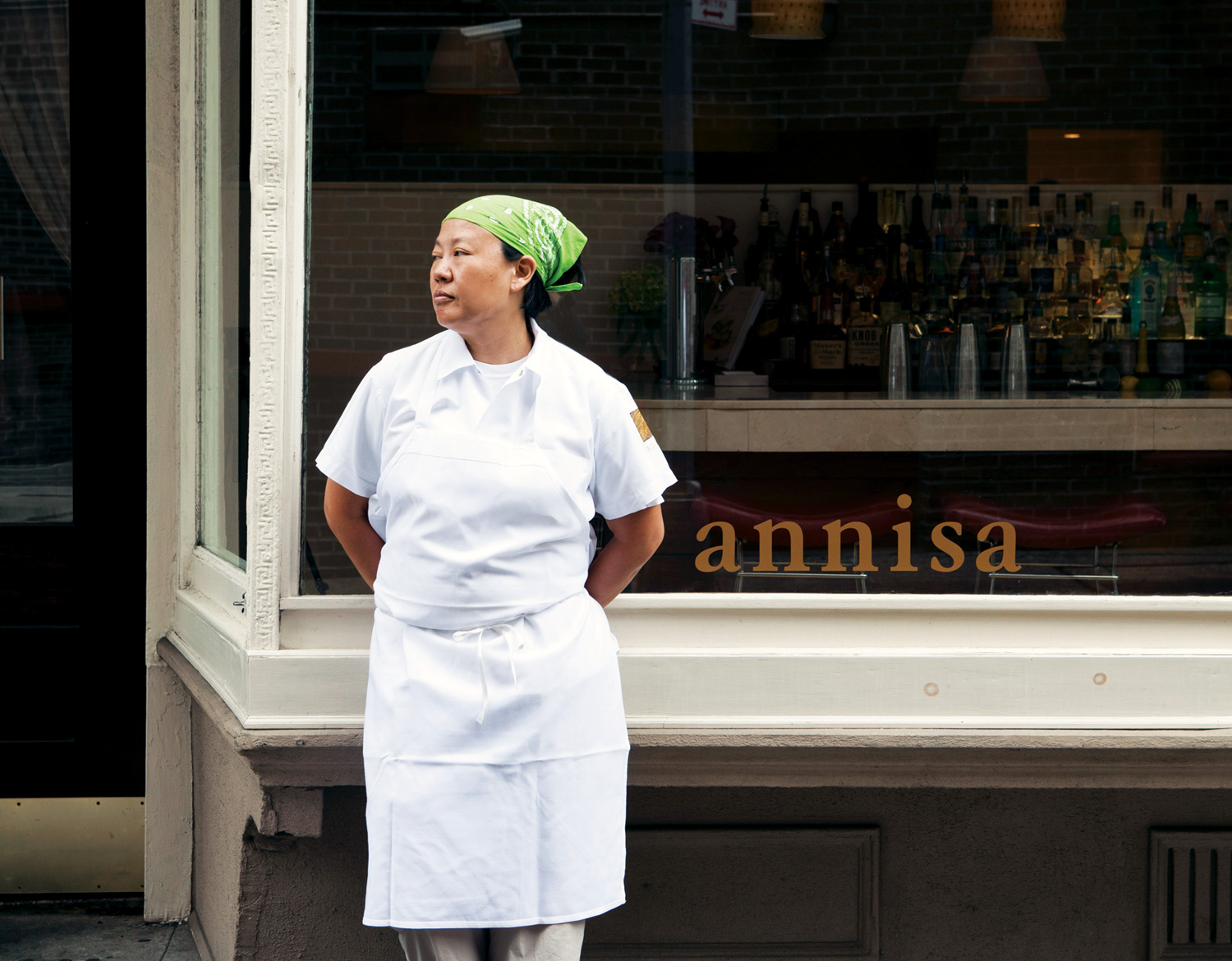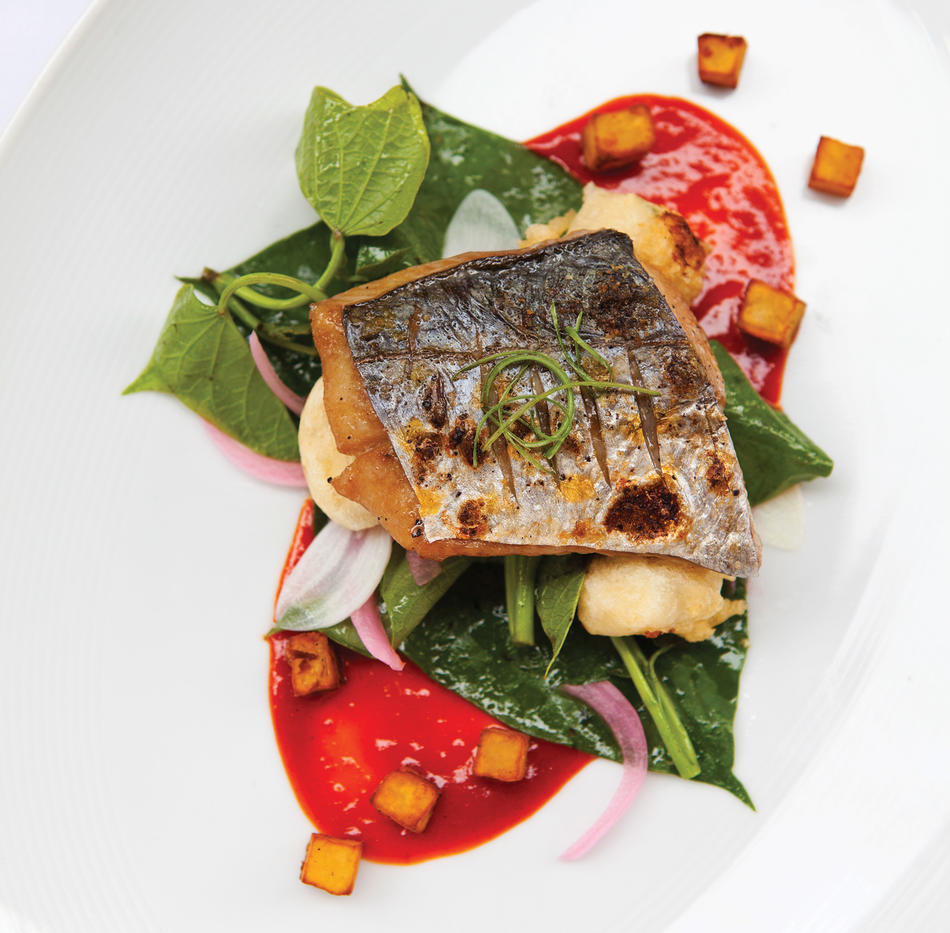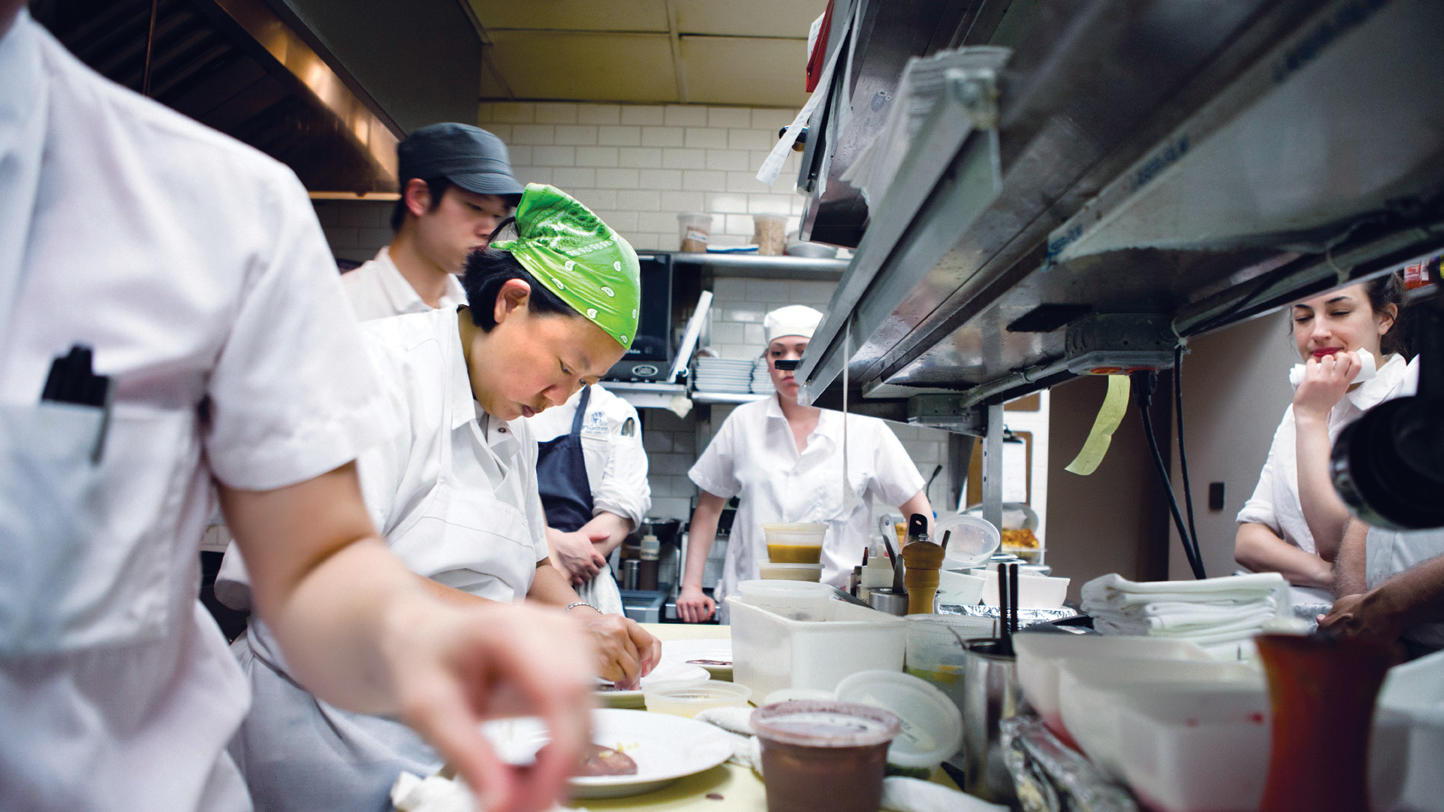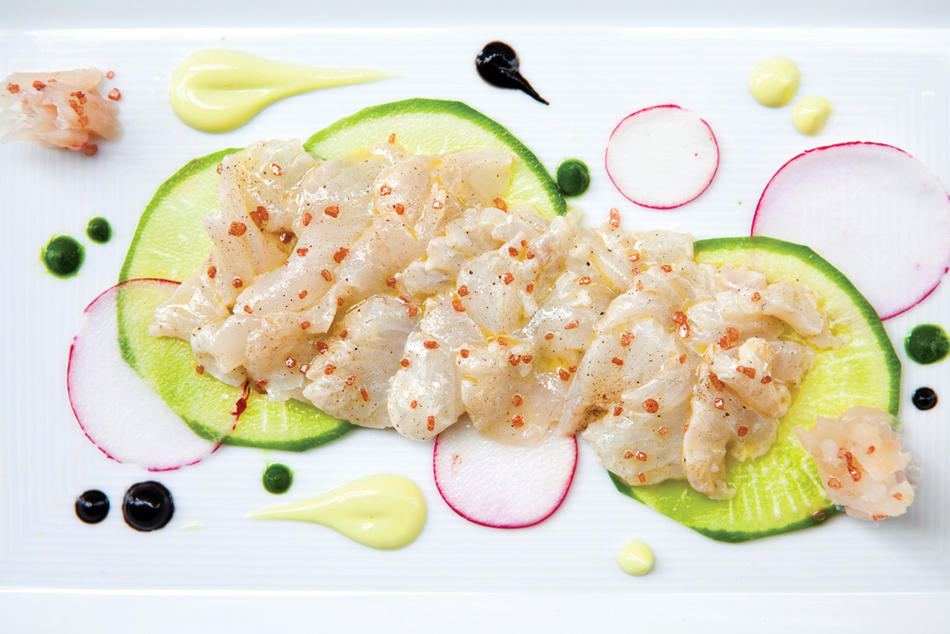
Anita Lo ’88CC has brains on the brain as she pulls onto Barrow Street, chains her bike to a lamppost, and slips through the door of Annisa, her twelve-year-old West Village restaurant. It’s just shy of 5:30 p.m. on a Thursday, and she’s running late; the first customers are only minutes behind her.
Lo flies past the bar, where prep is going on for the night’s service. Ella Fitzgerald scats on low volume as the bartender lines up rows of metal shakers on the marble countertop and extracts long curlicues of peel from half-carved lemons, limes, and oranges. In the small dining room, under muted yellow walls with little adornment save some branches suspended in vases, servers are memorizing the night’s specials and giving the silver a final polish. Another evening performance is about to begin.
About seventy reservations are on the books, by no means an unmanageable number, but enough to get away from you if you aren’t paying attention. Still, the seatings are evenly staggered throughout the night, so Lo will have some time to experiment.
Back to those brains. The gray matter in question, as spongy and unappealing as any jarred laboratory specimen, is from a calf that Lo had sought out from one of her meat purveyors that afternoon. “Some people have foragers,” Lo says, extracting the brains from their clear plastic container and turning them over to inspect them on all sides. “I am my own forager.”
The brains are a good find, since rhubarb is in season, and Lo has been looking for something interesting to pair it with. The brains, which have a high fat content, would be rich enough to cut the rhubarb’s tartness. Lo knows that for many of her diners, they will be unfamiliar, which is all the more reason for her to push them.
Lo’s staging area, a counter no more than five feet long and eighteen inches deep, sits in the center of the tiny but efficient kitchen. Two line cooks stand behind her, ready to grill, fry, and sauce, with another to her left making salads and cold appetizers, and a dishwasher, a few more steps away, already elbow-deep in suds.
Orders start coming in, and dishes start going out. Lo inspects a plate, wiping its rim clean before sending it out to the dining room. “Dice the confit a little smaller next time,” she tells a cook quietly.
She pulls things from the pantry: shallots, white balsamic, sugar, salt, cracked black pepper, and the rhubarb. As another cook turns to watch, she runs her knife over a sharpening steel before unleashing it on the crimson stalks, dicing them with small, elegant motions into fragments so regular that they could have made a perfect mosaic.
A waitress passes by on her way out to the dining room, carrying an order of Jerusalem-artichoke fritters topped with crisp baby artichokes. “Nash is on the books,” she tells Lo.
Lo stops mid-dice and, without a word, pulls out a black box stuffed with papers, clippings, and Post-its scribbled with intriguing words: fiddleheads, morels, black garlic, tripe. Inside is an inventory of many of the dishes she has served Nash, a regular customer who has eaten 339 meals at Annisa since record keeping began — not including his dozens of walk-in meals at the bar.
“If you’re my regular, then you’ve probably become my friend, and I’m going to cook especially for you,” says Lo, adjusting the lime-green bandanna anchoring her short black bobbed hair.
At times like this, when Annisa’s printed menu becomes more of a reference point than binding document, it is clear how cerebral Lo’s cooking can be. Unlike many chefs just a generation ago, who prided themselves on producing perfect versions of specific recipes, Lo is a part of a recent culinary tradition of perpetual experimentation. Her dishes are like equations, each ingredient a variable that can be adjusted according to what’s in season, what would appeal to a favorite customer, what new combination might present itself.
Out of the frying pan
Late one July night in 2009, Lo was sleeping at her weekend home in East Moriches, Long Island, when the phone rang. On the other end was her business partner and ex-girlfriend, Jennifer Scism, and the news was dire. Annisa, the restaurant that they had built from scratch, had been badly damaged in an electrical fire. It wasn’t clear yet how extensive the damage was, but Scism didn’t sound optimistic.
“My first thought was that things couldn’t get much worse than they already were,” says Lo. She had recently been forced to close her newer restaurant, Bar Q, as well as a branch of her takeout chain, Rickshaw Dumpling Bar, both victims of a sluggish restaurant economy after the 2008 stock-market crash. A few months earlier, her mother had died from a burst aneurysm. And now this?
The next day, she wound past the sun-washed summer homes of East Moriches, pulled onto the Long Island Expressway, and made the two-hour drive into the city, feeling as if she were going to the morgue to identify the remains of a loved one. Annisa, which she opened on a shoestring in 2000, was outfitted with equipment so old that the electrical couplings had simply melted. As soon as she walked in the door, it was clear: the place was beyond repair.
After nearly two decades of fifteen-hour days, Lo’s back ached, and her knees were shot. She longed for more time to read and write. Scism, for her part, wanted out; she was ready to leave the city and the restaurant business behind.
But Annisa was the place where Lo felt most at home, and she was hopeful about its future. She was working on a cookbook and had recently filmed a season of the television competition Top Chef Masters, placing fourth among twenty-four of the country’s most respected chefs. The show was set to air the next year, in 2010, and millions were expected to watch, which meant that the restaurant would certainly benefit. And then there were the twenty-two employees, many of whom felt like family. Lo often joked with them that she didn’t have an exit strategy. But this wasn’t the way she wanted it to end. Lo decided to take a chance.
Scism stayed on to help Lo oversee the design and reconstruction, though when Annisa reopened in April 2010, she said goodbye for good. “This was the first time Anita took sole responsibility for the restaurant,” says Scism from Maine, where she now lives with her husband. “I used to play bad cop to Anita’s good, and now she had to be both. She had to put all sides of her personality out there.”
Mise en place
Lo, who grew up the daughter of two doctors in suburban Birmingham, Michigan, was always someone with multiple sides: “I was Asian on the outside and white on the inside,” she says. “I know I don’t look the part, but I’m actually kind of a WASP.”
This was the result of a relatively prosperous childhood and parents who were hell-bent on their children assimilating. Lo’s father, Luke, who was originally from Shanghai, died when Lo was three; her mother, Molly, who grew up in a Chinese enclave of Malaysia, quickly remarried an American of German descent. Things weren’t always easy in their blended family, but love and respect for food brought them together.
“If you’re Chinese, you’re going to be interested in food,” says Lo. Molly was a passionate cook, often coming home after a fourteen-hour day to put six dishes on the table. She taught Lo to explore culture through her palate, which meant, at home, a mixture of China, Malaysia, Germany, and Hungary, thanks to a nanny who introduced them to dishes like paprikash and goulash. “She also had Mexican friends working around the corner, which meant tortillas, rice, and beans,” Lo says. “Delicious stuff.”
Lo and her family took long, unusual trips abroad. They went to Europe, Iran, Morocco, and Turkey, each destination chosen with a specific dish in mind. Lo ate reindeer in Copenhagen, frites and mussels in Belgium, and an intense, cold sour-yogurt drink in Iran, where Lo and her family were shuttled around in a black limousine. In Malaysia, Lo sampled tart, lychee-like rambutans in her aunt’s garden. “I parked myself in front of that tree and didn’t get up all day,” she recalls. Other relatives hosted long, elaborate banquets in China, which the family visited before Nixon did. “For most people I grew up with,” says Lo, “an exotic vacation was going to the Upper Peninsula of Michigan or maybe Florida. And here we were going to Tehran. We were freaks.” Returning to Michigan was always a letdown. For high school, Lo attended a small progressive school in Massachusetts with an international population. “My family was so ‘other,’” she says. “It was great to be in a place with so many ‘others’ like me.”
After she was accepted to Columbia, where she would major in French, Lo moved to New York, spending time with a high-school friend, Philip Anderson, whose mother, Susan Heller Anderson, was a writer for the New York Times food section. Philip had grown up partly in France, and he would feed Lo from a fridge filled with rillettes, cornichons, and other Gallic staples.
“At the time, Columbia’s was known as one of the four worst university cafeterias in the country,” says Lo. “I wasn’t giving in.” She moved off campus after her freshman year and learned to cook, starting with her childhood recipes — a mix of curry, laksa, chicken paprikash, and Chinese dishes — with the occasional splurge on lobster. She moved on to the original Joy of Cooking and early quick-cooking books by Jacques Pépin ’70GS and Pierre Franey. By senior year, she was an accomplished amateur.
Between her junior and senior years, Lo took her first trip to France, and spent it at La Varenne, a small but influential cooking school in Paris. She took four consecutive one-week courses, her first formal culinary training, and spent her free time shopping at local markets and treating herself to weekly dinners in city restaurants. “Clearly, I had a knack for cooking, and that experience brought it all together for me,” she says. Knowing then that food was going to be more than a hobby, she returned to La Varenne for a short stint after graduating. Back in the states, she found entry-level work at two important TriBeCa restaurants — Bouley, then Chanterelle — whose menus emphasized classical French cooking. In between, she returned to France for a six-month program at the École Ritz Escoffier. At these early jobs, she cemented her basic skills and her work ethic; Daniel Bouley remembers her chopping chives until she could do it without looking at the cutting board. She also gained a classical foundation on which to build her own distinctive style.
Wanting to expand her culinary outlook to include more Eastern flavors, Lo moved to a French-Vietnamese restaurant, Can, where she met Scism, who was working as a grill cook. But it was when Lo took the helm of a Korean restaurant called Mirezi that she caught the attention of the New York Times restaurant critic Ruth Reichl, who praised her inventive dishes and “beautifully arranged food” in a glowing review. After Mirezi closed in 1998, Lo and Scism spent a year traveling the world.
“Anita will eat anything,” says Scism, recalling a day in Bangkok when a vendor challenged Lo to eat a cockroach. “At one point, I told her she had a wing stuck in her two front teeth,” says Scism with a laugh. “The thing about Anita is, she didn’t try the bug because she was challenged; she tried it because she really was curious about how it would taste.”
By the time Lo returned to the States, so-called fusion cooking — combining ingredients and techniques from diverse cultures — had become popular. “As far as I was concerned,” she writes in her new cookbook, Cooking Without Borders, “fusion meant that my identity finally had a name.”
As fusion cooking spread, though, it became diluted and took on negative connotations. But for Lo, the concept still had great meaning. “Now we need another word to describe what is, in essence, all cuisine,” she writes. “There are no true borders in food. Each cuisine has been affected by another ... and food, like language, is constantly evolving. It is a living entity that grows and changes at each individual stovetop, at the hands of cooks across the globe.”
With that philosophy, Lo, with Scism, opened her own restaurant, Annisa, which means “women” in Arabic. Business was bumpy in the first years, as is to be expected from a new restaurant, but critical success was immediate. The Times twice awarded Lo two stars, and a coveted Michelin star followed in 2009, which she has maintained every year since.
Hook and line
Lo typically heads out to her weekend home on the North Fork of Long Island after service Saturday night to recover for a couple of days, often entertaining friends in the business. She rises around noon and says very little until she’s fed the dogs and had her first cup of coffee. The kitchen is impeccable, the walls lined with the same white subway tile as Annisa’s kitchen.
Out the window is a view of the water, and Lo goes out on it almost every day, on a borrowed eighteen-foot Parker fishing boat with a center console that allows her to walk the perimeter while she fishes for striped bass and bluefish. “I find few things as relaxing,” says Lo. “I love it.” If she catches something, she’ll haul it in and make it the centerpiece of a meal back at the house, sometimes using ingredients from her garden, where she grows herbs and Concord grapes, gooseberries, tomatoes, and sour cherries. “If I had more time, or the birds weren’t faster than me, I’d make pie,” she says.
Lo keeps a copy of the Annisa menu on hand and uses her downtime to conceive and test new recipes, integrating seasonal ingredients with obscure ones. Often, she is inspired by her surroundings — she cooked the first conch she ever caught, then thought of how she would serve it at the restaurant. But always there is a twist, a global emphasis. Take the seaweed she finds on the beach, for instance: “In Japan, it’s called hijiki, but if you put lemon, garlic, and olive oil on it, it tastes Mediterranean,” says Lo.
Food for thought
Midway through “Nash night,” all is smooth. The dining room is humming, and waiters bob and weave their way to the kitchen, where they pick up their next course and chat with Lo. Two years after the fire, a few staff members are new, but almost every single member of the old crowd returned, an exceptional show of loyalty in a fickle industry. Not that Lo is afraid to act like a boss. “If I need to explain something to you three times, I’m fine with that; it probably means I didn’t explain it well the first time,” she says. “But if I feel like there’s insubordination going on, we’ve got a problem.”
When Lo comes out of the kitchen, there is a flutter in the dining room, as diners crane their necks to get a glimpse of her, the TV star. But she is thinking about Nash. The plate from his first course comes back to the kitchen wiped clean. Lo makes a note, stuffs it into the Nash box, and then it’s back to the brains.
Lo gathers the rhubarb into two piles in front of her. One goes into a bowl with some sugar and white balsamic, a quick pickle in the making. Another is poached with wine and spices. Lo prods the dull-pink brains with her index finger, then carves a few ingots of rosy veal tenderloin from a cylinder of meat. She sears the tenderloin in a hot buttered pan, then dredges the brains in flour and flash-fries them, arranging the two proteins on a pristine plate. Next, she plates the rhubarb duo — poached with the loin, pickled with the brains — and adds a rich foie gras–laced sauce and another that’s earthy-silky with mushrooms and cream. Finally, a scattering of delicate morels, and the dish is ready for tasting.
Lo summons her cooks. They grab forks and taste the brains — crispy on the outside, creamy on the inside — together with the rest of the elements, a counterpunch of sweet, savory, tart, and rich. The feedback is unanimous: “Outstanding, Chef.”
She shakes her head slightly. “Needs tweaking; more acid,” she says, handing the plate to the dishwasher. “Work in progress.”





